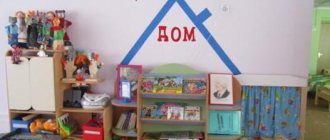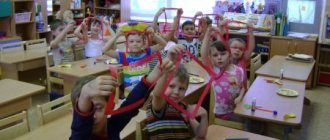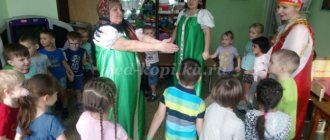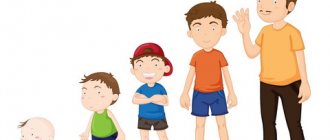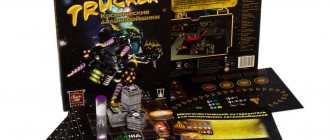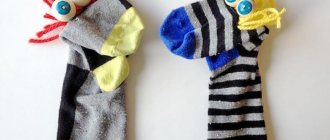Psychological characteristics of children in the senior group of kindergarten
By the age of five, a child already knows and can do a lot. At this age, memory is quite well developed. However, the most interesting things perceived on an emotional level are remembered more firmly. An older preschooler has a clear understanding of all types of emotions. He develops various feelings: curiosity, a sense of humor, surprise, a sense of beauty, pride, friendship, etc.
Children aged 5-6 years show creative activity in various fields of activity. The development of fantasy and imagination is often expressed in the composition of funny stories. With all this, the child is attentive to any comments from the adult and tries to act, guided by his advice.
The natural characteristics of an older preschooler create favorable conditions for successful performances.
A fairy tale brings variety to a child’s life, gives him joy and is one of the most effective ways to develop speech, in which the principle of learning is most clearly manifested: learning by playing.
The peculiarity of the fairy tale is that the development of a preschooler’s personality occurs in harmony with the successful acquisition of literate and coherent speech. A fairy tale is an integrative activity in which the actions of an imaginary situation are associated with real communication aimed at activity, independence, creativity, and regulation of the child’s own emotional states.
Unfortunately, today many children by the age of five have a level of speech development below the norm. The level of transmission of emotional states is underdeveloped, artistic abilities, intonation, perception of various shades of speech do not correspond to an adult.
And a fairy tale is an excellent way to eliminate all these problems. The process of playing a fairy tale itself is closely connected with all sections of the program, which include the development of speech in preschool children. Playing a fairy tale helps to activate different aspects of children’s speech:
Dictionary; Grammatical structure; Dialogue and monologue speech; Improving the sound side of speech.
A new role, especially the dialogue of characters, confronts the child with the need to express himself clearly, distinctly, and intelligibly. His dialogical speech and its grammatical structure improve, he begins to actively use the dictionary, which, in turn, is also replenished.
By participating in theatrical activities, children get acquainted with the world around them in all its diversity through images, colors, sounds, and correctly posed questions force them to think, analyze, draw conclusions and generalizations, and contribute to the development of mental abilities.
Theatrical activities create conditions for the development of creative abilities. This type of activity requires from children: attention, intelligence, speed of reaction, organization, the ability to act, obeying a certain image, transforming into it, living its life. Therefore, along with verbal creativity, dramatization or theatrical production is the most frequent and widespread type of children's creativity. V.G. Petrova notes that theatrical activity is a form of experiencing the impressions of life, lies deep in the nature of children and finds its expression spontaneously, regardless of the wishes of adults.
The greatest value of children's theatrical activities lies in the fact that dramatization is directly related to the game (L.S. Vygotsky N.Ya. Mikhailenko), therefore it is the most syncretic, that is, it contains elements of the most diverse types of creativity. Children themselves compose, improvise roles, and stage some ready-made literary material.
It is theatrical activities that are a unique means of developing the artistic and creative abilities of children. Solving problems aimed at developing artistic and creative abilities requires the definition of a different technology, the use of theatrical techniques and their combinations in an integral pedagogical process.
At the same time, in practice we observe that the developmental potential of theatrical activities is not used enough. How can this be explained?
1.Lack of study time, i.e. total workload of teachers.
2. Involvement in the theater is not widespread, which means that some children remain outside this type of activity.
3. Misunderstanding of the importance of theatrical activities for the development of a child.
- Preschoolers have no experience in perceiving theatrical art. There is an unsystematic and superficial familiarization with the theater in kindergarten and in the family, which develops in children the idea of an accessible perception of the stage design of works without special knowledge.
- Theatrical games are used mainly as a “spectacle” at holidays. The child is taught to be a “good artist”, to memorize the text, intonation, and movements. However, the skills mastered in this way are not transferred to free play activities.
6. Non-interference of an adult in theatrical play. The children are left to their own devices, the teacher prepares the attributes for the theater.
The same set of hats and masks, elements of the heroes’ costumes move from group to group. Younger preschoolers are attracted to this because of the opportunity to change clothes, but the older preschooler is not satisfied because it does not correspond to his cognitive interests, the level of development of mental processes, and the possibilities of self-realization in creative activity. The consequence is the complete absence of theatricality in the play experience of children 5-7 years old, even if they have an interest in this activity and a need for it.
A contradiction arises: on the one hand, there is recognition by art history and pedagogical science of the importance of theater in the emotional and creative development of a child. On the other hand, there is a shortage of theatrical art in children's lives.
Overcoming this contradiction is possible only by ensuring a synthesis of theatrical activities by introducing children to theater as a form of art and organizing the theatrical and play activities of the children themselves.
By its nature, theatrical art is closest to children's role-playing play, which develops as the basis for the relatively independent functioning of the children's community and by the age of 5 takes the position of leading children's activity. The forms of organization of these processes are similar: play - role-playing and acting.
Theatrical activity meets the psychological characteristics of preschool age, satisfies the child’s basic need - the need for play, and creates conditions for the manifestation of his creative activity.
The musical component of theatrical performances expands the developmental and educational capabilities of the theater, enhances the effect of emotional impact on both the mood and attitude of the child, since a coded musical language of thoughts and feelings is added to the theatrical language of facial expressions and gestures. The natural predisposition of preschool children to singing and movement explains their keen interest in perceiving musical and theatrical performances and participating in them with pleasure.
The process of creating (staging) a musical fairy tale is labor-intensive, but interesting, requiring painstaking work from teachers. The main goal of creating a musical fairy tale with preschool children is to develop children's ability to freely creatively perceive the world around them.
Stage 1 “Selecting a work”
A fairy tale is a collective work, therefore the choice of a fairy tale should be a collective one. Since children do not have a rich literary background, the teacher brings up known and unknown fairy tales for discussion, skillfully guiding the search process. It is necessary to take into account the abilities and characteristics of the children's team. Since preparing a fairy tale requires a lot of time and creativity, it is better if the fairy tale corresponds to the theme of the upcoming holiday or entertainment. This will save the energy of children and adults, and will give every child the opportunity to be an artist and feel their importance.
Stage 2 “What kind of fairy-tale hero is he?”
Working on fairy tale characters contributes to the development of mental processes - memory, imagination, fantasy, speech. Musicality and musical culture are formed, which is part of the general culture. In the process of work, you can rely on children’s imagination, the child’s personal experience and memory. The teacher offers to tell and show how he imagines this character. Since the children’s personal experience is not yet great, we correct and help, suggesting the most striking individual traits and characteristics of the character. They help me with this:
Sketches for facial expressions
- For example: working with cards of emotions with a brief description of them: “The hare was scared”, “The offended hare”, “Brave hedgehog”, “Angry wolf and bear”, “Sly fox”.
- technique “Choose a card”, “Who is this?” - one child shows an emotion with facial expressions, and all children choose the appropriate card.
Sketches for movement
- For example: “The fox is coming” - walk on “soft paws”.
- “Save the bunny”, “Delicious jam”, “Dance of the animals”, “Bees are working”, “Mow hay”, “Let's go by bus”.
- technique “Guess who it is?” - one child shows, the other names (guesses) the character of the fairy tale.
The child begins to understand that if you present the subject in question well and say it expressively, then the text is remembered better and faster. Interaction with partners and participation in the performance becomes more and more exciting. Knowing and imagining their hero well, being able to speak his words clearly and expressively, children easily cope with the facial expression of the image. Of course, some still need help to “wake up” the facial muscles and teach their face to be happy, sad, angry, or laugh. Psycho-gymnastics M.I. Chistyakova will help the teacher with this. Each character has its own special creative characteristic. The brightness of the image is achieved in different ways, including musical ones.
Stage 3 “Formation of the cast (distribution of roles)”
For some time, children are immersed in the magical world of music and fairy tales, creating it themselves, learning to watch and listen. During this time, the following is formed:
group of soloists;
- acting group;
- a dancing group.
Children's desires, range of interests are identified, and preferences are identified. The guys tried themselves in all roles - animate and inanimate. We played in different episodes. Now is the time to take responsibility for a specific role in order to bring the performance to the audience. Children are given the opportunity to try themselves in one role or another. During the performance, the child evaluates himself. On the other hand, his comrades evaluate him. The group of children expresses their wishes and determines their sympathies. The joint choice of children and teachers determines the performer of a particular role. The last costume rehearsal is underway.
Stage 4 “Introduction to the musical design of the performance”
The artistic word and music complement each other, enhance the impressions of what they hear, encourage children to pick up pencils or paints and express their impressions on paper, in movement, in a solo vocal performance.
All the musical material that the child encounters develops musical memory throughout the performance. Music to listen to and music to perform require memorization in order to follow the progress of the performance, interact with partners, remember your musical theme and perform it during the performance. To find a plastic solution to the image of some characters, choreography classes are necessary. Children learn to convey an image in movement by performing various etudes at the stage of “dance creativity”, as part of music classes.
Stage 5 “Creating a stage space”
Creating a stage space requires children to be able to navigate. Determine the boundaries of this action, divide the space into sectors, lines, and the main place of action. Know the sides: left, right, back, forward, diagonal. Determine the middle and edges. Rearrangement exercises contribute to the development of orientation. To better visualize the pattern of changes, children are offered a visual series of pictograms. Having learned to see and understand space, children quickly find a place for themselves, partners and objects with which to interact. Children's improvisation and associative thinking come into force. There is a need to use objects (both decorations and substitute objects). Interaction with partners leads to the creation of mise-en-scène.
The teacher remains, without imposing his vision, to “inhabit” the space together with the children. Elements of scenery and props find their exact place on the set during the rehearsal of episodes (mise-en-scène). And the elements of the costume find their performer.
Stage 6 “Premiere”
Performance is the most exciting and important stage in creating a musical fairy tale. The child gets the opportunity to express himself and believe in himself, to feel the joy of communicating with peers and adults, who are assigned the role of helpers and connoisseurs. The social and personal development of the child is carried out.
A sense of responsibility for a common cause is formed...
...The poster is ready. The artists are worried. Spectators are waiting. So, the premiere!
Goals of dramatizing fairy tales in preschool educational institutions
Turning to the dramatization of fairy tales allows the teacher to realize the main goals:
- Educational. During preparation for the dramatization, children of the older group get acquainted with folk art, some properties of a fairy tale as a literary work, learn to analyze the character of the characters and their actions, and correlate the actions of the characters with real people.
- Developmental. Dramatization helps develop imagination, attention, memory, emotional sphere, expressiveness of speech, improve communication and motor activity in their combination.
- Educational. The dramatization of fairy tales fosters interest in literary works, folklore, and fairy tales of individual authors; forms aesthetic taste, strengthens feelings of friendship, support and mutual assistance.
Dramatization of the fairy tale "The Tailor Hare". Preparatory group
DRAMATIZATION OF THE TALE “THE HARE IS THE TAILOR” PREPARATORY GROUP.
Introduction for parents:
THE GUYS AND I HAVE BEEN STARTING FAIRY TALES FOR YEARS AND THIS YEAR WE ARE CONTINUING OUR TRADITION. THEATER FOR CHILDREN IS A GAME. AND PLAY IS THE MOST IMPORTANT THING IN A CHILD’S LIFE.
WITH THE HELP OF TODAY'S TALE WE WILL ACCOMPLISH THE FOLLOWING TASKS:
-improving children’s skills to convey the images of fairy tale characters;
- consolidate knowledge about the tailor’s profession; - develop dialogical speech; - form friendly relationships; — we cultivate honesty and responsibility in relation to our promises and words.
TODAY WE WILL SHOW YOU THE TALE “THE TAILOR HARE”. SHE TALKS ABOUT A KIND, HARDWORKING BUNNY WHO COULD SEW. AND WHAT HAPPENED NEXT, YOU WILL NOW FIND OUT ABOUT IT....
Fairy tale script:
The presenter rings the bell, attracting the attention of the audience.
The bell rings like it sings a song, He invites a new fairy tale to visit us. And, if it gets a little quieter here, Then a fairy tale will come, and we will hear it.
Shh!
Presenter: puts a finger to his lips and listens.
Music is playing.
Do you hear? Do you hear? Here she is! But remember, a fairy tale needs silence...
The presenter again puts his finger to his lips as a sign of silence. The introductory music for the performance plays.
Why has everything changed? Why did everything sparkle? Did you laugh and sing? Well, tell me, what's the matter? Children: It’s so easy to understand: Spring has come to us again! Leading:
Nature is waking up. This happens year after year: Updates his outfit. The animals also all want to update their outfit. See: “The Tale of the Hare, who knew how to sew and wanted to please everyone.” In a clearing, in a forest, Under a tall pine tree, A wonderful, painted house. And he lives in that house, the gray hare everyone knows - a wonderful tailor.
Hare: (rises from the chair)
Yes, I am not a simple Hare, I am the best tailor. Animals, what should I sew for you? I will accept any order.
Presenter: Spring has come to the forest - it’s red, And everyone has no time for sleep: I want to be beautiful - I need to hurry to the Bunny. The news flew through the forest, reached the village, and Barbos found out about it: He was the first to bring his order.
Dog Barbos: I am a shaggy and shaggy Dog Barbos. Very brave and courageous Dog Barbos. I guard the owner's yard, Woof - woof - woof. I bark angrily at strangers, Woof - Woof - Woof. Day and night I guard the big house, I serve faithfully and diligently! Woof! Hello, Zainka - oblique! I heard that you are a tailor.
Hare: That's right, I can sew everything. I try to please everyone.
Dog Barbos:
Hurry to me, Zainka,
Sew a new hat. It's cold at night. I'm afraid I'll catch a cold very soon!
Hare: In a day or two I will finish my work. You come to my house for a hat on Saturday. (Hare takes measurements)
What material should I take for a dramatization game in the senior group of a preschool educational institution?
The dramatization game can be carried out on various materials: Russian folk tales, author's tales, works in poetic form or in prose. Children aged 5-6 years already perceive quite well even such fairy tales as “Cinderella” by C. Perrault or “Thumbelina” by G.-H. Andersen.
Here are some examples of Russian folk tales: “The Boasting Hare”, “Emelya”, “Winged, Hairy and Oily”, “The Frog Princess”, “Sivka-Burka”, “Havroshechka”, “The Fox and the Hare”. Also favorite are the works of V. Suteev (for example, “The Bag of Apples”), C. Perrault (“Little Red Riding Hood”, “Cinderella”) and other writers.
Preparation process
The teacher’s main tools when organizing fairy tale dramatizations will be a card index and a game outline. The card index includes basic information about various dramatizations. The card indicates the goals of the staging, attributes and decorations, and a short course of the game. A synopsis is a detailed description of the dramatization itself.
In the process of preparing for the event, the teacher discusses with the children the topics that are touched upon in the chosen fairy tale, and also analyzes the events and characters in detail. Preliminary work takes a lot of time, but the result depends on it.
We invite you to familiarize yourself with some recommendations for the dramatization of the Russian folk tale “The Boasting Hare.”
